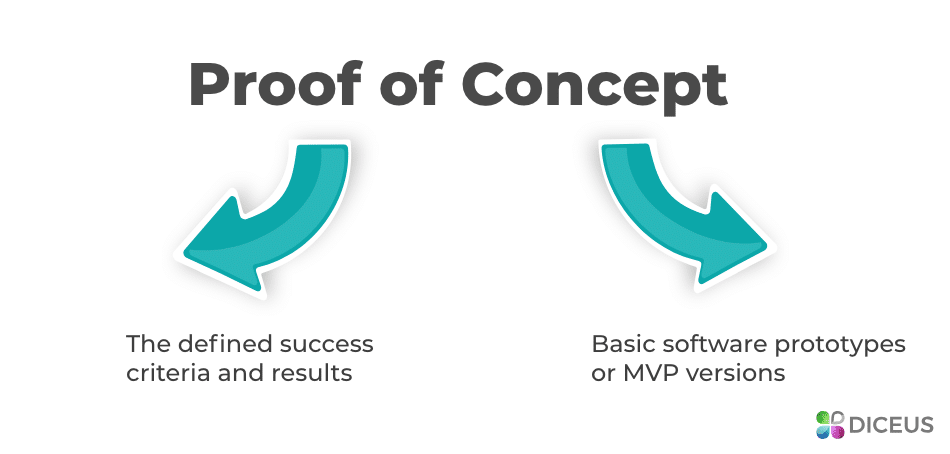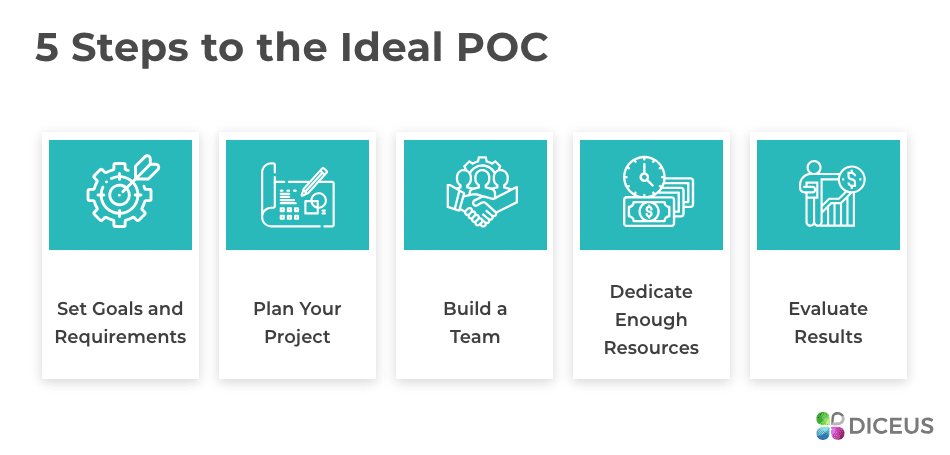

Top 5 steps to define crucial POC success criteria
It’s difficult to hit the spot in today’s market conditions. You may think that going with this or that trendy technology or solution will certainly engage the widest range of your target audience. You can bet on a business decision or product based on past experience. The exact result of how your offer hits the market is pretty challenging to predict.
Companies and service providers do everything to make this point more predictable and keep up with the competition – analyze competitor solutions in the same market niche, conduct surveys and A/B testing procedures. The initiative focused primarily on seeing how well one’s TA receives a product concept is defined by one specific abbreviation – PoC or Proof of Concept.
What is PoC and how the assessment of product feasibility with its help aids businesses in keeping their heads above the water? Let’s figure out the PoC meaning in the software industry by going through the ins and outs of this process.
What is PoC in software?
Proof of Concept ultimately helps to gather first-hand market insights with the help of a basic product concept offered to an audience of users to try out. It is, basically, a timely way to test project-defining ideas, decisions, strategies, and methods. The main goal of PoC software is to shed the light on the final product’s feasibility, i.e., decide whether it should be fully implemented or not.
Demonstrating and perfecting a product based on real feedback may seem to be more about MVP (Minimum Viable Product), but there are underlying differences between the two approaches (we highlight them in the section below). Timely implemented PoC helps avoid a huge range of possible errors and pitfalls when creating and launching new software products in the market without going too far in terms of functionality.
What does PoC mean to business success?
Figuring out the essential PoC definition in terms of its ultimate business benefit, it’s important to define success as a whole. Success means achieving the set goals. In business, this usually means reaching the desired volume of sales, acquiring an extensive range of customers, and getting good revenue.
To reach a business project success, the following essentials must be figured out and settled:
- Stakeholders. Define all the people that will be a part of your project – deliver it, receive it, or judge it. Knowing the principal values of your target audience is especially important. Remember that everyone affecting or getting affected by your project in hand is a stakeholder, who’s opinion is paramount to your success.
- Goals. What is the major purpose of your whole project? What would you want to bring to the existing market? What budget do you approximate? You should understand what you wish to see as a result of the whole effort and move on based on that.
- Problems. Being prepared for the worst in full arms is another element of success. The main issue-spawning moments in software project development are usually costs, end quality, responsible staff, and schedule and scope of underlying work. Add market competition, potential edits, and possible pitfalls on top of that. All these aspects should be lined up beforehand.
- Criteria. You should be able to reflect your major goals in more detailed criteria. For this, you can either look up commonly used KPIs or come up with your own criteria. The main aspects that your criteria should cover are project completion time limits and the scope of the available budget.
It all comes down to the fact that it’s crucial to know what to expect from your business solution. PoC greatly helps in figuring this out point by point. Let’s take a closer look.
PoC in software and its stages
Getting to the basics of the process – there are two main pillars to PoC:
- Concept. Your concept is your software product blueprint or an early MVP solution that defines the basic points of the future solution. It may even have no functionality, although it makes sense to implement certain aspects.
- Proof. The project is proven feasible if it can potentially match the goals and criteria you settled with and promise a valuable user experience. You can figure this out by gathering feedback about your PoC and conducting test cases.
Poor PoC initiative can result in grave consequences. You can set the wrong direction for the whole development cycle by accident. It is important to treat a PoC phase as a full-on project of itself. It is as important as other major software development stages. That’s why a sufficient budget and a professional team should be dedicated to the process.
On top of that, your software Proof of Concept should be balanced. Focus on core features, capabilities, and concepts. Only the essentials go. However, if there are too few elements and definitions, it may not be enough to deliver a bigger picture of the project for users. But overloading it with elements and test scenarios is a no-go as well – leave all the secondary stuff for the MVP phase or further full development.
Lastly, you need metrics – they act as points of comparison with baseline results, input desirables for A/B tests and project analysis as a whole. You should be able to measure KPIs in terms of your particular project specifics.
Why does your IT project need a Proof of Concept?
Your business ultimately requires a Proof of Concept initiative if you are not looking to offer some sort of improvement to something that already exists in the market with your future product. Rather, you’re planning to introduce something innovative and never-before-seen. Bringing something new to the masses is almost always a leap into the unknown. The PoC phase helps figure out the most probable potential demand for what you’re looking to offer.
When you don’t have much competition to analyze and borrow well-tried-and-tested practices, it’s only logical to test out the core of your solution in the field to see whether people need to have it in their life at all. All in all, PoC will come in more than handy if you don’t have that much budget yet but know exactly what you’d like to offer and have some unparalleled feature that deserves a good demonstration.
How to verify your project idea – Alternatives to PoC
Project idea verification has been recognized among top-priority business efforts for some time now. And more than one practice has been developed for such a purpose. Apart from PoC, companies also create prototypes and MVPs.
- Prototype – if the main goal of PoC is to figure out project feasibility, prototypes are made to demonstrate the essential functionality of the product. It is more about moving parts that people can “touch and feel” early on.
- MVP – a minimum viable product is kind of a combination of a PoC and prototype where the basic concept may be reinforced with the “alpha-version” functionality. MVPs are created in order to identify the potential product demand among the target audience of users.
Depending on the specifics of a project in hand and budget, any of these implementations may come in handy. We highlight when exactly it’s better to go with which initiative further down the article. A common practice is to implement the whole “PoC-Prototype-MVP” cycle. If you have what it takes, you may go with it if you want the most precise guarantees of product relevance. However, one efficient project verification may be just about enough.
What is the difference between PoC and MVP?
The major difference between the two concepts is that MVP has more “flesh” on its “bones”, i.e., it is a more functional solution that has the core features that best present the product. PoC is a bit more abstract. The meaning of PoC is about verifying the sole idea that doesn’t have much functionality yet. With MVP, it’s more about testing an unpolished product in the field to see if it gets the required level of demand.
Steps that guarantee successful PoC software launch
Even if you have an innovative, promising project idea in mind, checking its feasibility beforehand may save you tons of nerves in the long run. And the only thing that’s worse than avoiding PoC as a whole is poor PoC. How to write a Proof of Concept outline and implement the process most beneficially? Here are the major stages of a reliable PoC project
Setting requirements and goals
Go from generals to particulars. Make success your ultimate goal and try to come up with the underlying tasks. Answering the following questions should help you settle with how to write PoC that brings efficiency:
- What are the underlying tools and processes you should verify?
- What are the main strengths of similar solutions in the market?
- What are the main weaknesses of similar solutions in the market?
- What issue to solve or need to satisfy is your concept aimed at?
- Who is the target audience of your finished solution?
- What essential metrics are you going to use?
Planning a project
Planning is paramount. Think through the importance of which particular points you need to verify with your PoC. These would probably include the following major elements:
- Data. You need to verify compliance with security standards, the convenience of storing data, etc.
- Functionality. You need to verify that the software can help users solve predefined issues or satisfy particular needs.
- UI/UX. You need to verify if the planned interface and user experience will truly engage users and make their life easier.
Gathering a team
You need reliable specialists to implement the project. Never underestimate the strict requirements for the skills and qualifications of developers, managers, and analysts to be involved. Ideally, these people should share the focus on particular goals and needs of the whole process.
When it comes to PoC, involving all possible stakeholders is very important. Your team should ultimately have the essential guidelines in hand – goals, deadlines, requirements, and so on. The true professionals will help induce your project with a powerful collaborative effort and adjusted communication.
Allocating resources
Budgeting is among the fundamental pillars of your project. In particular, you should have enough costs to provide product/idea field testing. Based on the approximate scope of work defined during planning, calculate potential costs for team financing, deployment, and support of your product.
Assessing results
Once the PoC phase is launched, you should focus on examining reports and evaluating the results of test runs. Let the responsible specialists do their work, see the deliverables in the respective PoC document, and compare these results to the market standards. This is where thorough monitoring is essential. In the long run, you should polish up a PoC reinforcing the future product that is most likely to hit the spot.
The ultimate Proof of Concept evaluation criteria checklist
You can find many options of a Proof of Concept template online. There are common points that help you understand that your PoC project is a well-established effort. Here is the most standard list of Proof of Concept success criteria examples:
- All involved project participants accept major requirements and goals
- Financial and human resources are defined and prepared
- There are clarified suggestions for each project stage
- There are prioritized technical and business features
- The overall PoC workflow is outlined
Do you need PoC or MVP?
As we mention above, there are several approaches to verifying the project idea, including Proof of Concept, prototype creation, and MVP implementation. These can either be used altogether in a subsequent cycle or picked individually depending on your project specifics.
Thus, if you have an exclusive idea and just need to throw it out there to see that it’s definitely worth the effort – go with the PoC. If the main feature is a certain functionality or you already have some pre-built software – a prototype is a way to go. And if you have a big picture of the project in mind and enough budget, you may as well create an MVP to see how the solution fits the market and whether it meets any of the relevant user needs.
Launch projects with us!
We hope we help you figure out the Proof of Concept definition software-wise and make your life easier with the approximate software Proof of Concept template. The rest is up to you, one thing’s for sure – you should definitely enter the market armed to your teeth with thorough analysis and preparation. And if you are looking for reliable specialists to handle your PoC – contact us. We have seasoned professionals to properly check the feasibility of your project via PoC or assess your product’s most closely approximate demand with a high-quality MVP. You tell us what you need – we handle clean work.







